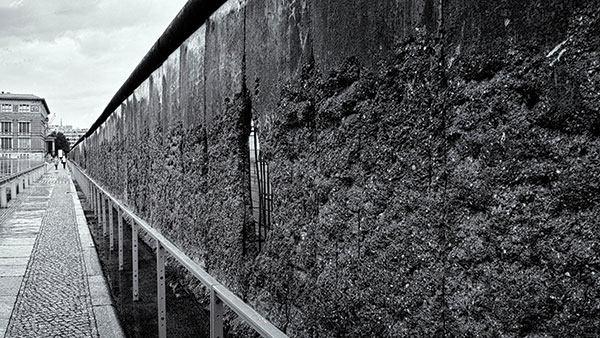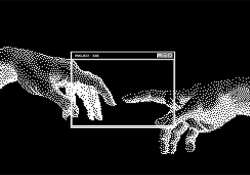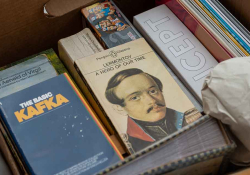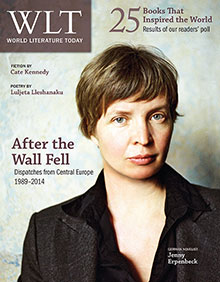Narrating the Fault Lines: German Literature since the Fall of the Wall

Since the fall of the Berlin wall, a rich literary culture has emerged that grapples not only with Germany’s past but also the multilayered experiences of the present and struggles over German identity.
Twenty-five years after the fall of the Berlin Wall, certain images from November 9, 1989, remain: crowds celebrating at rock-and-roll concerts at the iconic Brandenburg Gate, East German cars crossing into West Berlin, reunited family members embracing one another, and West and East Germans working together to bring down the physical barrier that had separated them for the past twenty-eight years and thus, metaphorically, the politics that had divided them for the past forty. A media spectacle to end the German twentieth century on a note of triumph and togetherness, the fall of the Berlin Wall appeared to promise the long-awaited triumph over a horrific, and what many deem to be historically abnormal, century.
While the media reveled in the jubilation following November 9, 1989, many German intellectuals approached the impending unification of East and West Germany with caution and even skepticism. Prominent East German author Christa Wolf urged her compatriots to shape the new nation in such a way that the ideals of Communism could be realized, while author Volker Braun could only mourn East Germany’s defeat by the capitalist system. West German author and Nobel laureate Günter Grass criticized the notion of unification bitterly, arguing that the atrocities committed at Auschwitz should prohibit Germans from having a unified nation. Indeed, the fall of the Berlin Wall and the reconifiguration of the European map that would follow prompted serious questions about nation and identity in Europe, particularly in Germany: What form would unification take? How would the identity of former East Germans be understood within the capitalist framework? How should Germans understand themselves as citizens of a democracy when their last democratic system as a unified nation had failed, giving rise to fascism? Could Germany be trusted when faced with conflict? Or might the fall of the Berlin Wall actually mean a historical break from the terrible twentieth century? If so, would this event mark a cultural shift in the way Germans related to the past?
A spate of literary scandals that followed the fall of the Berlin Wall and German unification demonstrated just how embroiled literature was in the politics of memory.
A spate of literary scandals that followed the fall of the Berlin Wall and German unification demonstrated just how embroiled literature was in the politics of memory. Christa Wolf was among the first to be thrust into the limelight when the publication of her autobiographical novella What Remains (1990) resulted in both the accusation of opportunism—critics contended that she should have published the critical novella in 1979 when she had written it instead of in the post-Communist era—and the revelation that Wolf had worked for a period of time as a collaborator with the Stasi, a fact that made her novel appear to be a justification of her actions. Similar scandals would follow over the next two decades that focused on West German literary giants, most notably Martin Walser and Günter Grass. Walser came under attack after he asserted in his acceptance speech for a major literary prize in 1998 that the media’s focus on the Holocaust had turned it into a “moral cudgel” and a “routine threat” instrumentalized by the left for political purposes. In 2006 it would come to light that Grass had served in the Waffen SS during the Nazi era, a fact that he had managed to keep quiet while emerging as one of the most vociferous critics of West German society in the postwar era.
These literary scandals in the 1990s and 2000s cast doubt on the intellectual elite who had served as the moral compass for decades in both East and West Germany. Coupled with the social perception that the fall of the Berlin Wall had marked an end to the historical narrative of the twentieth century, these scandals made way for a new generation of authors to emerge who were seemingly apolitical and post-ideological. Authors like Joachim Bessing, Sibylle Berg, Thomas Brussig, Christian Kracht, Thomas Meinecke, Elke Naters, Andreas Neumeister, Matthias Politycki, and Benjamin von Stuckrad-Barre, among others, created a new pop aesthetic that glorified consumer culture, fashion trends, and popular music. Dubbed the “new archivists,” these authors listed brand names, song titles, bands, and designers in their works, thereby documenting what was cool and popular in the post-unification era. They kept their focus on the surface, avoiding deep engagement with political ideology, psychology, or emotions, and demonstrated their savvy by plugging into global digital media.
A new wave of women writers created an even more impactful, and more lasting, shift in the literary scene. Labeled by the German media the literary “girl wonder” writers (a cringe-worthy term because of its patriarchal and historical implications, but a marketing charm nonetheless), authors such as Sibylle Berg, Karen Duve, Jenny Erpenbeck, Julia Franck, Alexa Hennig von Lange, Jana Hensel, Judith Hermann, Zoë Jenny, Elke Naters, Kathrin Schmidt, and Juli Zeh, among others, published texts of high literary quality that were also fun to read. Their novels, short stories, and Internet projects overlapped in some respects with the tendencies of pop literature, for example, by foregrounding Berlin as the political and metaphorical center of German unification. However, their works also emphasized women’s perspectives and experiences in the newly unified Germany. The pop authors and the new influx of women writers introduced what the media called a “new readability” in German literature. Their literature was less burdened with the labor of coming to terms with the past, easier to consume, and therefore more successful on the global book market than German literature of previous decades had been. More importantly, this shift in the literary scene can be seen as indicative of the larger concerns of the new nation: Germany of the new “Berlin Republic” was eager to be seen as having overcome the burdens of its past and to be accepted into the international community.
* * *
While many of the tendencies of 1990s popular literature have subsided—for example, the intense focus on Berlin, the aestheticization of the surface, and the thematization of the jet-setting melancholy bourgeoisie—certain characteristics of this era have made a lasting impact on contemporary literature. German literature has subsequently turned its attention back to its troubled past, but in a way that is guided aesthetically by the “new readability” of the 1990s. Rather than working through the cultural repercussions of the Second World War and the Holocaust in an aesthetically challenging way intended to make the reader grapple with comprehension, logic, and language (as per the dominant literary styles of the 1960s–1980s), German literature since the turn of the twenty-first century is exemplified by sweeping novels that write the Second World War and the Holocaust into a larger narrative of the German twentieth century.
The Familienroman (family- or generational novel) has become the most popular, and also the most important, genre for exploring the history of the German twentieth century and for examining our subject positions in the twenty-first century vis-à-vis the past. The generational novel traces large-scale social and historical shifts through the focalizing lens of the family across generations, typically starting with a grand- or great-grandparent’s generation at the turn of the twentieth century and tracing the family history through the First World War, the Weimar Republic, the Second World War, the occupation period, the developments of West or East Germany, and, finally, with the youngest generation coming of age in the era of unification. The Familienroman as a literary genre followed on the heels of highly publicized intellectual debates from the late 1980s through the 1990s that centered on the question of whether the social taboo against discussing German suffering during the Second World War had actually impeded the nation’s ability to come to terms with the past, and the earliest novels of the genre focus specifically on German experience during and following the Nazi era.
Uwe Timm’s autobiographical Familienroman, In My Brother’s Shadow (2003), tells the story of his family from the 1940s to the present, recounting the terror they faced during the fire bombings of Hamburg, the starvation of the postwar period, and the hardship caused by the failing family business following the initial economic boom of the 1950s. What stands at the center of family tensions, however, is the absence of Uwe’s older brother, Karl-Heinz, who had volunteered for the SS and died from complications of surgery after being severely wounded on the Eastern front. Timm’s painful autobiographical novel is devoted to piecing together a picture of this much older brother, of whom he has only a single memory. Throughout the novel, Timm is faced with conflicting feelings about his brother, who had presumably seen and committed unspeakable acts against Eastern European Jews and Russian soldiers, but who was remembered in the family as a gentle spirit and the favorite son of his father. The novel is structured in a collage-like manner as Timm painstakingly searches for clues about his brother in letters, photographs, family anecdotes, and personal memories. It is exemplary in the way it focalizes the atrocities, loss, and hardships of the German twentieth century through the family narrative and for its aesthetic emphasis on the fragmentary and prosthetic nature of memory.
Erpenbeck’s most recent novel, The End of Days (2012), presents a radical shift in perspective on the German twentieth century. The novel centers on a female protagonist of Eastern European Jewish heritage and thereby focalizes the events of the twentieth century through the specific hardships and challenges that Jewish women have faced.
While a number of authors have examined the German twentieth century through the lens of the family narrative, Jenny Erpenbeck’s work has been innovative in foregrounding artifacts as material markers of memory. In her much-lauded novel Visitation (2008), it is not a family that witnesses the twentieth century but, rather, a house. Erpenbeck’s most recent novel, The End of Days (2012), presents a radical shift in perspective on the German twentieth century. The novel centers on a female protagonist of Eastern European Jewish heritage and thereby focalizes the events of the twentieth century through the specific hardships and challenges that Jewish women have faced. Moreover, Erpenbeck’s novel takes place largely outside of Germany, thus giving literally—geographically—an outsider’s perspective on the implications of German history. The various settings of the protagonist’s life—Polish Galicia at the turn of the century, Vienna during the rise of fascism, Russia during the Nazi era, East Germany in the postwar period, and, finally, Berlin after unification—underscore that the “outsider’s” perspective is often the most incisive one.
The End of Days is a brilliant study of loss and mourning, proposing five different versions of the life and death of the central character, a girl/woman who remains unnamed until the end of the novel. The central question of the book—How many instances of death must one avoid in order to live a full life span?—frames daily life in the twentieth century as a minefield that can only be survived through careful navigation and luck. Book 1 centers on the mourning of a family who has lost an eight-month-old infant who died in its sleep. The novel opens with the statement, “The Lord giveth and the Lord taketh away . . . But that wasn’t right, because the Lord took away much more than was there.” Death didn’t take just a baby, but also the schoolgirl she would have become, the woman who would have worked and argued with her mother, and the older woman who would have perhaps had children herself. With this opening statement about the thieving nature of death, the book also outlines its own structure.
Each “book” of the novel proposes a stretch of life, and death, of the central character. Book 1 gives the backstory of the family around which the novel will center, telling of the deceased baby’s grandmother, who survived a pogrom in Polish Galicia in the mid-nineteenth century that resulted in the arrest and murder of her husband and barely spared her prized possession, the complete works of Goethe. Her subsequent desire to marry her daughter into a Christian family, despite her own father’s wishes, results in her father’s disavowal of his granddaughter’s marriage. Book 1 also traces the separation of the baby’s mother and father following her death, the mother slipping into a life of prostitution and the father emigrating to America.
Each of the following books of the novel is preceded by an intermezzo that proposes a “what if” scenario that extends the life of the child. What if the parents had opened the window and used a handful of snow to resuscitate the baby? What if the family had then moved to Vienna? In book 2, the baby has grown into a girl who experiences starvation and cold in Vienna in the aftermath of World War I and whose need motivates her to become politically active. She witnesses vicious anti-Semitism, is discouraged by her parents from having contact with her Jewish grandmother, and eventually commits suicide after the loss of a lover. (But what if, proposes the intermezzo, she discovered writing as a way of dealing with her emotions rather than committing suicide?) In book 3, she has become a revolutionary young Communist who moves to Ufa and then Moscow and begins writing for a German-language journal. When she is suspected of being a Trotskyite, however, she is arrested and killed in a prison camp. (But what if, by a fluke of the bureaucracy, her file was put in a separate stack and she was never arrested?) In book 4, she becomes a celebrated author who has immigrated to East Germany to help shape the cultural consciousness of the new Communist country but dies by pure accident, falling down a flight of stairs coming out of her apartment building in Berlin. (But what if she didn’t trip?) In book 5, she has grown into an elderly woman who experiences the post-unification era in a retirement home with others of her generation, whose stories of the German twentieth century are going unheard because of mental decline, death, and the younger generation not knowing which questions to ask.
Erpenbeck’s novel foregrounds the fault lines of intergenerational memory. As the narrative takes different turns according to the “what if” scenarios proposed between each book, certain stories and bits of information get passed on while others remain untold. Erpenbeck’s narrative strategy further underscores how easy it can be to lose track of information. The narrative perspective changes frequently and is completely relational. That is, the third-person narrator and the narrators within the story speak only of each other, not themselves. Instead of proper names, they are referred to only by relational markers, such as “the mother,” the grandmother,” “the grandfather,” “the son,” and so on, subject positions that shift when generational lines change, as with a birth or a death. The main character is referred to by a number of such markers: the baby, the older daughter, Comrade H, the mother, and, finally, in book 5, her proper name, Frau Hoffmann. Continuity, it seems, exists best in material artifacts. Family heirlooms, such as a set of gold buttons featuring the emblem of the Austro-Hungarian empire, a footstool, and a clock, are passed from generation to generation. The Goethe collection spared during the Galicia pogrom makes its own way through the twentieth century, having been confiscated by the Nazis when the main character’s grandmother was deported and eventually killed in a concentration camp, and rediscovered decades later by her great-grandson in an antique store.
Erpenbeck’s novel chronicles the twentieth century in a way that other Familienromane do not. It foregrounds the specific challenges Jewish women have faced due to anti-Semitic violence, including pogroms, restriction of food and other resources from Jews in times of famine, and deportation and murder during the Holocaust. The protagonist and the women around her are constantly faced with the threat of having to resort to prostitution, a struggle that marks women’s specific experience of survival during the horrors of the twentieth century.
* * *
Although Germany’s history does not stand in the foreground of Hermann’s stories, the set of challenges this history presents the post-unification generation looms over her characters and contributes to their debilitation.
While authors such as Timm and Erpenbeck work through the difficult twentieth century in their narratives, others, such as Judith Hermann, investigate the traces of that past on present German society. When her debut collection Summerhouse, Later appeared in 1998, Hermann was hailed by critics and scholars alike as giving voice to the generation of West Germans coming of age in the post-unification era. Although she is considered a leading figure of the “girl wonder” writers and the “new archivists,” her works defy the characterization by the media that popular literature of the 1990s was apolitical and ahistorical. In this breakthrough work, Hermann thematizes the unprecedented mobility that this generation enjoyed while at the same time aestheticizing the melancholy, boredom, and emotional detachedness of those young West Germans who did not find satisfaction in a life of jet-setting and city bohemianism. Her protagonists, most of whom are first-person narrators, are introspective and narcissistic, transient by choice, and have only fleeting attachments to place and one another. Although Germany’s history does not stand in the foreground of Hermann’s stories, the set of challenges this history presents the post-unification generation looms over her characters and contributes to their debilitation.
The first story of the collection, “The Red Coral Bracelet,” is a meditation on the enduring presence of the past, as the narrator tells the story of her great-grandmother’s love affairs as a German woman in Russia on the brink of the Russian Revolution. The connection the narrator feels with her great grandmother is represented symbolically and materially by a red coral bracelet that she inherited. The bracelet had been a gift of one of her grandmother’s lovers, and the narrator accidentally destroys it as her own love relationship falls apart.
The narrator tells her great-grandmother’s story in a style reminiscent of a fairy tale. Long ago and far away, the beautiful young German woman was forced into an isolated life in Russia when her husband was hired to build ovens there. Lonely and homesick, the young woman remained indoors while her husband was away on business for long stretches of time. When the locals heard of the beautiful German woman who lived alone, men began visiting her. She took a number of lovers, many of whom gave her jewelry and other trinkets as tokens of their affection. When her husband returned and noticed the red coral bracelet—which continues to gleam with a luminescent radiance that symbolizes passion in the story—he left the house in a rage and challenged her latest lover to a duel. He was killed in the duel, and seven months later, the narrator’s great-grandmother gave birth to her lover’s child in the beginning days of the Russian Revolution before managing to flee to Germany.
The narrator and her lover are both descendants of the same Russian society, and the narrator’s desire for her lover is really a desire to connect with that past. The fact that her lover does not identify with this heritage and refuses to speak about it causes a strain on their relationship. She seeks the advice of a therapist, the only person her lover will talk to. While at the therapist’s office, however, the narrator becomes so nervous that she pulls the threads of the bracelet and accidentally breaks it, the beads springing from her wrist and scattering onto the floor. In a panic, she realizes she cannot pick them all up. The destruction of the red coral bracelet marks the end of her relationship with her lover and her realization that the past is diffuse and unwieldy, ultimately out of her control.
Another story in the collection, “Hurricane (Something Farewell),” centers on a group of jet-setting Berlin youth visiting a Caribbean island on the invitation of an expatriate friend named Kaspar. It opens as the group is playing a game titled “imagine a life like” in which they dream up stories about the direction each other’s lives could take. This game is indicative of the youths’ outlook on life: they imagine future lives that are plausible, given their means and mobility, yet remain passive and drifting, avoiding taking the necessary action to give their lives direction. During the story, the group is passively occupied by their games, by romantic interests with island locals, and by the suspense created by two events: a daredevil hang glider who has announced his trip to the island and a forecasted hurricane. Ultimately, however, neither of these events prove to add real meaning or excitement to the characters’ lives. They become bored with the hang glider and stop watching before he actually takes off, and the hurricane bypasses the island.
The group’s economic and ethnic privilege becomes apparent when Kaspar, the group’s host, reproaches his friend Christine for her romantic involvement with an island inhabitant named Cat because of its potential ramifications for the island community. He reveals that Cat is only interested in Christine because of her ethnic difference from him, and that Cat has a wife who has left him because of the affair. Christine responds that she knows about Cat’s marriage and prepares to leave the island. Instead of a new life with Cat, she must be satisfied with the game. The fantasy has consequences in the real world, however, which is made clear in the story’s postscript. After Christine returns to Germany, she receives a message that Cat is still waiting for her. She had promised him she would return, a lie that has spurred on his own fantasy of a different life with her.
“The Red Coral Bracelet” and “Hurricane (Something Farewell)” illustrate Hermann’s achievement of creating introspective and passive characters who are also implicated in larger global politics and history. “The Red Coral Bracelet” insists on the continued influence of the past on the present era of unification. It casts a romantic gaze on a past that predates Cold War tensions to explore deeper cultural roots shared by East and West. “Hurricane (Something Farewell)” taps into neocolonialist fantasies in the post-unification era, ultimately showing the damaging effects of ethnic and economic privilege. Other stories in Hermann’s collection similarly point to the challenges of reconciling history and the present. For example, the titular “Summerhouse, Later” and “This Side of the Oder [River]” portray West Germans moving into spaces in the former East Germany that had been restricted to them prior to the fall of the Berlin Wall. Any hopes for building a different life in these newly accessed spaces are dashed, however, as the western youth finds these places run down, ruled by conventional gender norms, and no more conducive to personal connections than the West.
* * *
One of the most striking shifts in the German literary scene since the fall of the Berlin Wall is its polyphonic, multiperspectival, and multicultural nature. Not only has it become more frequent in the post-unification era for German novels to be narrated from a plurality of perspectives (e.g., Erpenbeck’s The End of Days); but there is an unprecedented array of works written in German by authors of non-German heritage, by authors of German heritage living in or hailing from other countries, and by women, all groups that have historically been marginalized by a rather narrow literary canon. The guest-worker program of the 1960s and 1970s, the deportation (and, later, emigration) of ethnic German Romanians to West Germany after the Second World War, the invitation of Russian Jews to Germany after unification, and the overall increased mobility (and displacement) of people from the former Eastern bloc in the 1990s have all supported the influx of literary voices from authors who speak German as a second language or as a member of an ethnic minority.
One of the most striking shifts in the German literary scene since the fall of the Berlin Wall is its polyphonic, multiperspectival, and multicultural nature. One of the breakthrough voices in German literature has been that of Hungarian German author Terézia Mora. Having left Hungary for Germany in 1990, Mora began writing tenaciously about the struggles of living at the social margins.
Literary critics and scholars continue to debate the implications of terms like “the Turkish turn,” “the Eastern turn,” “the spatial turn,” “diasporic writing,” “literature of migration,” and the now outmoded “girl wonder,” all of which have become shorthand for describing large-scale shifts in the German literary landscape following the fall of the Berlin Wall. These authors, in turn, have contributed innovations in aesthetics and themes, creating a contemporary literature that, while focused intensely on Germany’s history and politics, has become in many ways international. These authors experiment with modes of linguistic and cultural translation, the aesthetics of estrangement and motion, and ways of depicting the experience of cultural marginalization:
- For example, Wladimir Kaminer, a Russian Jew who immigrated to Berlin in the 1990s, has become a popular icon, lampooning both the habits specific to Germans that seem strange to outsiders and the multicultural scene of the German capital.
- Japanese German writer Yoko Tawada’s travel narratives and sophisticated play on the German language effectively dismantle the perceived binaries of East and West, Orient and Occident. For Tawada, orientation is a matter of subject position, and her constantly changing narratives show just how tenuous our binaries are.
- Bulgarian German writer Ilija Trojanow thematizes displacement, drawing on his own experience in his earliest works to portray the circumstances of refugee life. In later works, he chronicled his travels to Africa, India, and his own homeland of Bulgaria and has become outspoken in criticizing the limitations on free speech imposed globally by American politics.
- Perhaps the most high-profile marker of success by a foreign-born German author is the bestowal of the Nobel Prize in Literature on German Romanian author Herta Müller in 2009. Müller takes on political oppression and violence in her works, depicting hard-lived realities under Communism, particularly under the repressive regime of Nicolae Ceauşescu. Her much-lauded novel The Hunger Angel (2009) depicts the deportation of ethnic German Romanians to Soviet gulags during the Nazi era and their forced labor there.
Since the establishment of a sizable Turkish population in West Germany during the 1960s, Turks have come to comprise Germany’s largest ethnic minority. Following the tradition of Turkish German literature, the third generation is now writing its own perspectives on Germany in the post-unification era. Emine Sevgi Özdamar has become a leading figure in contemporary Turkish German literature, having pioneered the aesthetics of linguistic hybridity and cultural translation. A first-generation emigrant to Germany, Özdamar was first a guest worker in West Berlin in the 1960s and 1970s before pursuing a career in theater in East Germany and Turkey and eventually publishing fiction in Germany in the 1990s. Her novels and short stories depict the experiences of her autobiographically based Turkish German protagonists who cross borders between Germany and Turkey, as well as East and West Berlin, with ease. She depicts experiences specific to migration through metaphors of the body, by embedding these new experiences within larger family narratives, and by focalizing her protagonists’ experiences through feminist narratives of self-actualization and independence.
In her semi-autobiographical novel Strange Stars Stare Down at Earth (2003), Özdamar’s first-person narrator lives in West Berlin in 1976–77 and travels on a daily basis to East Berlin to perform her duties as an intern at the Volksbühne (people’s theater) under the direction of Benno Besson. She has recently left Turkey to escape both a failed marriage and a ruined theater career after a military putsch left an oppressive regime in place that persecutes leftists. While in Berlin, she belongs to a small experimental living community in which free love and open body culture are components of a program to increase individual freedom. Over the course of the novel, she travels repeatedly between Turkey and Germany, as well as between East and West Berlin, enjoying access to both sides of the wall that few Germans have. This mobility not only gives her freedom, however. She experiences her mobility as a responsibility to interpret and communicate what she sees as unbalanced power relations in those spaces she traverses. She focuses specifically on describing the circumstances of prostitutes—both in Germany and in the Volksbühne’s production of Bertolt Brecht’s The Good Person of Szechwan—and of Turkish guest workers who cross the border daily, raising families in East Berlin and working in the West.
Authors such as Özdamar, Zafer Şenocak, and Yadé Kara demonstrate that Turks are not as absent from the narratives of German history as mainstream German cultural productions might suggest. Yadé Kara’s hit unification novel Selam Berlin (2003), to give another example, centers on Turkish-German teenager Hasan Kazan’s experiences of the fall of the Berlin Wall and the immediate post-unification era. Hasan spends the novel not only dealing with the typical struggles of teenage boys (girls, sexuality, strife with parents, and educational and career decisions) but also reflecting on his own identity in light of unification between East and West Germany, exploring areas of East Berlin he previously had no access to, watching the transformation of the family’s business that had thrived on arranging flights between East and West Germany, and coming to terms with a family secret that had been concealed by the wall.
One of the breakthrough voices in German literature has been that of Hungarian German author Terézia Mora. Having left Hungary for Germany in 1990, Mora began writing tenaciously about the struggles of living at the social margins. Her disorienting and exhilarating debut novel, Day In Day Out (2004), is a masterfully written aesthetic expression of displacement. The very first sentence of the novel—“Let us call the time now; let us call the place here”—flies in the face of reader expectation to be oriented in a time and place within the diegetic world, thereby establishing disorientation as both a theme and an aesthetic principle for the novel. Moreover, the plot opens with a troubling event: two women have just discovered Abel Nema, the enigmatic translator, dangling bound and unconscious from a jungle gym in a neglected urban playground. The narrative that follows is devoted to the characterization of Abel through a tableau of perspectives that pieces together his life story.
Abel is a citizen of no land, a refugee from a Balkan country that no longer exists (presumably Yugoslavia) who immigrates to an unspecified city in the West (probably Berlin) after accidentally missing his draft call and becoming a deserter (of that land that soon would no longer exist). The moment that initiates Abel’s trajectory into an emigrant life—and which prefigures his sexual attraction to adolescent boys as an adult—takes place on the evening of his high school graduation, when he confesses his romantic love to his childhood friend Ilja and is rejected. Driven by this sense of rejection, Abel leaves home and visits one of his father’s former lovers whom he had met years before. After surviving natural-gas poisoning while on that visit, which leaves him unconscious for three days and causes him to miss his draft call at home, Abel discovers he has developed a freak ability to learn languages quickly, accurately, and without accent. Upon learning that he has missed his draft call and is now considered a deserter, Abel immigrates to a new country, seeks the financial support of an expatriate professor, and devotes himself to the study of languages. Abel becomes a polyglot and translator, speaking ten languages without accent. However, his linguistic abilities do not lead to social integration in the new place, as one might expect. Rather, he retains his “scent” of foreignness (as his wife, Mercedes, would describe it) and remains almost exclusively in the company of immigrant and refugee groups, including a troupe of bohemian musicians, a gang of gypsy children, a schemer named Konstantin who provides transitional housing to illegal emigrants, and a network of expatriate intellectuals who grant scholarships.
Abel is not only foreign, however; he ultimately proves to be unknowable. He is always narrated from an outside perspective, unable to speak about himself (except in one chapter toward the end of the novel, in which he narrates a hallucinatory drug trip). Thematically, Abel’s inner emptiness is indicative of a loss of identity, both politically (he has no citizenship) and in terms of having a sense of self that is rooted in a place. Not only has Abel experienced the trauma of losing his home; his home does not even exist anymore and cannot ever be returned to. Abel also never feels settled in the West. He is capable of translation, border crossing, and transient living, but not settling and anchoring his identity in a place.
The themes Mora presents in this novel—homelessness, the emotional ramifications of social marginalization, and the political and economic limitations that result from displacement—are the stuff of tragedy. However, her writing is filled with delightful absurdities that make the novel fun to read. Certain characters are grotesquely funny, such as the neighbor who disappears mysteriously for three days and insists he visited heaven, as well as the glitter-covered and toga-clad clientele of the sex club Abel patronizes. The tone of the narration borders on the picaresque, giving this world a grotesque and sometimes magical feel. When moments of sobering violence occur—such as a scene in which the police raid and destroy Abel’s apartment and arrest him and his roommates—the shift in tone underscores the oppressive realities of migration.
Abel is powerless, always late, dresses in a slovenly manner, is valued primarily for his freak abilities, and is even studied by brain researchers. Throughout the novel, he exemplifies transience, rootlessness, and disorientation. Despite, or perhaps because of, his strangeness, his predilections, his lack of substance, and his metamorphoses, Abel is an intriguing figure. Abel Nema is a man that few readers will identify with, but he nevertheless intrigues us. Mora has achieved a character and a narrative style that decenter her readers, disorient us, and beg us to forgive the sins of sex and vice. Moreover, the narrative is labyrinthine, spatially, temporally, and in terms of narrative perspective, unmooring readers through a sense of constant instability. With this novel, Mora jolts us out of our normal modes of identification to sympathize with someone who is truly different, an achievement in its own right.
* * *
German literature today, while still enjoying the impulses of “new readability” that emerged in the decade following the fall of the Berlin Wall, continues to work through difficult historical material that informs national and regional identity. Perhaps more importantly, literature in the Berlin Republic has demonstrated that Germany does not have just one difficult past but a plurality of difficult pasts, made accessible by the many new voices in the field. While the media images of November 9, 1989, continue to propose a happy ending to the terrible twentieth century, the multiperspectival nature of German literature tells a very different story—or, better yet, many stories.
Kansas State University












